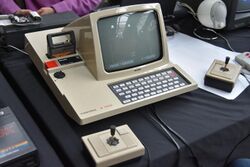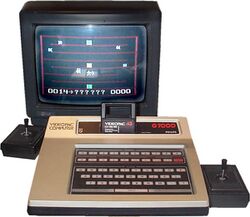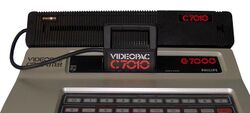Engineering:Magnavox Odyssey²
 | |
 The Magnavox Odyssey² and its two hard-wired Joysticks | |
| Also known as | Philips Odyssey² (United States )
Philips Videopac G7000 (EU) Philips Odyssey (Brazil ) Odyssey2 (Japan ) |
|---|---|
| Developer | Magnavox, Philips |
| Manufacturer | Magnavox, Philips |
| Product family | Magnavox Odyssey series/Philips Odyssey series |
| Type | Home video game console |
| Generation | Second generation |
| Release date | |
| Lifespan | 1978–1984 |
| Introductory price | US$179 (equivalent to $701.66 in 2019) |
| Discontinued | March 20, 1984[1] |
| Units sold | 2 Million[4] |
| Units shipped | unknown |
| CPU | Intel 8048 |
| Memory | 64 bytes RAM, 1024 bytes ROM |
| Removable storage | ROM cartridge |
| Sound | yes |
| Controller input | Joysticks |
| Touchpad | yes |
| Online services | no |
| Mass | unknown |
| Best-selling game | unknown |
| Predecessor | Philips Odyssey 2100 |
| Successor | Philips Videopac+ G7400 |
The Magnavox Odyssey², also known as Philips Odyssey², is a second generation home video game console that was released in 1978. It was sold in Europe as the Philips Videopac G7000, in Brazil as the Philips Odyssey and in Japan as Odyssey2 (オデッセイ2 odessei2). The Odyssey² was one of the major three home consoles prior to the 1983 video game market crash, along with Atari 2600 and Intellivision.
In the early 1970s, Magnavox pioneered the home video game industry by successfully bringing the first home console to market, the Odyssey, which was quickly followed by a number of later models, each with a few technological improvements (see Magnavox Odyssey series). In 1978, Magnavox, now a subsidiary of North American Philips, decided to release an all-new successor, Odyssey².
In 2009, the video game website IGN named the Odyssey² the 21st greatest video game console, out of its list of 25.[5]
Design

The original Odyssey had a number of removable circuit cards that switched between the built-in games. With the Odyssey², each game could be a completely unique experience, with its own background graphics, foreground graphics, gameplay, scoring, and music. The potential was enormous, as an unlimited number of games could be individually purchased; a game player could purchase a library of video games tailored to their own interest. Unlike any other system at that time, the Odyssey² included a full alphanumeric membrane keyboard, which was to be used for educational games, selecting options, or programming (Magnavox released a cartridge called Computer Intro! with the intent of teaching simple computer programming).
The Odyssey² used the standard joystick design of the 1970s and early 1980s: the original console had a moderately sized silver controller, held in one hand, with a square housing for its eight-direction stick that was manipulated with the other hand. Later releases had a similar black controller, with an 8-pointed star-shaped housing for its eight-direction joystick. In the upper corner of the joystick was a single 'Action' button, silver on the original controllers and red on the black controllers. The games, graphics and packaging were designed by Ron Bradford and Steve Lehner.[6]
One other difference in these controllers is that the earliest releases of the silver joystick were removable. They could be plugged and unplugged from the back of the unit, while all later silver and all black controllers were hardwired into the rear of the unit itself (although the joysticks still can be easily replaced, but not without dismounting the cover deck).
One of the strongest points of the system was its speech synthesis unit, which was released as an add-on for speech, music, and sound effects enhancement. The area that the Odyssey² may be best remembered for was its pioneering fusion of board and video games: The Master Strategy Series. The first game released was Quest for the Rings!, with gameplay somewhat similar to Dungeons & Dragons, and a storyline reminiscent of J. R. R. Tolkien's The Lord of the Rings. Later, two other games were released in this series, Conquest of the World and The Great Wall Street Fortune Hunt, each with its own gameboard.
Its graphics and few color choices, compared to its biggest competitors at the time—the Atari 2600, Mattel's Intellivision and the Bally Astrocade—were its "weakest point".[7] Of these systems, the Odyssey² was listed by Jeff Rovin as being the third in total of sales, and one of the seven major video game suppliers.
Market life
United States
The console sold moderately well in the U.S. It was one of the three primary consoles prior to mid-1982, though a distant third, after the Atari 2600 and Mattel Intellivision. By 1983 over one million Odyssey² units were sold in the U.S. alone.
To sell would-be customers on its technical abilities as a computer-based console, the Odyssey² was marketed with phrases such as "The Ultimate Computer Video Game System", "Sync-Sound Action", "True-Reality Synthesization", "On-Screen Digital Readouts" and "a serious educational tool" on the packaging for the console and its game cartridges. All games produced by Magnavox/Philips ended with an exclamation point, such as K.C. Munchkin! and Killer Bees!.[8]
No third-party game appeared for the Odyssey² in the United States until Imagic's Demon Attack in 1983.[9] The lack of third-party support kept the number of new games very limited, but the success of the Philips Videopac G7000 overseas led to two other companies producing games for it: Parker Brothers released Popeye, Frogger, Q*bert and Super Cobra, while Imagic also released Atlantis.
Europe

In Europe, the Odyssey² did very well on the market. The console was most widely known as the Philips Videopac G7000, or just the Videopac, although branded variants were released in some areas of Europe under the names Philips Videopac C52, Radiola Jet 25, Schneider 7000, and Siera G7000. Philips, as Magnavox's Dutch parent company, used their own name rather than Magnavox's for European marketing. A rare model, the Philips Videopac G7200, was only released in Europe; it had a built-in black-and-white monitor. Videopac game cartridges are mostly compatible with American Odyssey² units, although some games have color differences and a few are completely incompatible, such as Frogger on the European console, being unable to show the second half of the playing field, and Chess on the American model, as the extra hardware module could not work with the console. A number of additional games were released in Europe that never came out in the U.S.
Brazil
In Brazil, the console was released as the Philips Odyssey; the Magnavox Odyssey was released in Brazil by a company named "Planil Comércio", not affiliated with Philips or Magnavox. Odyssey became much more popular in Brazil than it ever was in the U.S.; tournaments were even held for popular games like K.C.'s Krazy Chase! (Come-Come in Brazil). Titles of games were translated into Portuguese, sometimes creating a new story, like Pick-axe Pete, that became Didi na Mina Encantada (Didi in the Enchanted Mine) referring to Renato Aragão's comedy character, and was one of the most famous Odyssey games in Brazil.
Japan
The Odyssey² was released in Japan in December 1982 by Kōton Trading Toitarii Enterprise (コートン・トレーディング・トイタリー・エンタープライズ, a division of DINGU company) under the name オデッセイ2 (odessei2). "Japanese" versions of the Odyssey² and its games consisted of the American boxes with katakana stickers on them and cheaply printed black-and-white Japanese manuals. The initial price for the console was ¥49,800, which is approximately US$200 in 1982, but roughly $500 in 2018. It was apparently not very successful; Japanese Odyssey² items are now very difficult to find.
Games
Technical specifications
- CPU
- Intel 8048 8-bit microcontroller running at 1.79 MHz
- Memory:
- Video:
- Intel 8244 (NTSC) or 8245 (PAL) custom IC
- 160×200 resolution (NTSC)
- 16-color fixed palette; sprites may only use 8 of these colors
- 4 8×8 single-color user-defined sprites; each sprite's color may be set independently
- 12 8×8 single-color characters; must be one of the 64 shapes built into the ROM BIOS; can be freely positioned like sprites, but cannot overlap each other; each character's color may be set independently
- 4 quad characters; groups of four characters displayed in a row
- 9×8 background grid; dots, lines, or solid blocks
- Audio:
- Intel 8244/8245 custom IC
- mono
- 24-bit shift register, clockable at 2 frequencies
- noise generator
- NOTE: There is only one 8244/8245 chip in the system, which performs both audio and video functions.
- Input:
- Output:
- RF Audio/Video connector
- Péritel/SCART connector (France only Videopac C52)
- Media:
- ROM cartridges, typically 2 KB, 4 KB, or 8 KB in size.

- Expansion modules:
- The Voice: provides speech synthesis and enhanced sound effects. Unlike Intellivoice, games compatible with The Voice did not require it; Danny Goodman of Creative Computing Video & Arcade Games predicted "that eliminates any incentive to buy the $100 voice module".[10]
- Chess Module: the Odyssey² did not have enough memory and computing power for a decent implementation of chess on its own, so the C7010 chess module contained a secondary CPU with its own extra memory to run the chess program
- Videopac+/Jopac-compatible only, Microsoft Basic. The rare C7420 Home Computer Module, made available in 1983 by Philips, was a costly extension for the newer Videopac+ and Jopac consoles only. It went with a thick A4 manual, and required an optional external tape recorder to save the programs. This module was the sole valuable justification of the presence of a so-called keyboard, which was supposedly designed to look like a hybrid educational toy, as read in header lines describing earlier this family of pluri-purpose consoles, even in the TV commercials that echoed the slogan written on these brand-new machines: “Video Computer”. Unfortunately, this late niche concept, even limited to learning game code contrary to the more professional packaging, could not resist at all the already overwhelming market of the real 8-bit home computers, where the Atari 400 shared the same look in 1979, surprisingly. [The latter was advertised itself: « The affordable home computer that's easy to use even for people who've never used a computer before ».] This expensive module is not to be confused with the cheap cartridge #9: Computer Intro!)
Emulation
An open source console emulator for the Odyssey² called O2EM is available. It includes Philips Videopac G7400 emulation among other features. The emulator works on Linux, Microsoft Windows, DOS and other platforms, and is included within OpenEmu for Mac OS X. O2EM, (originally not open source) was created in 1997 by computer programmer Daniel Boris and further enhanced by André Rodrigues de la Rocha.
The open source multi-platform multi-system emulator MESS has Odyssey² support, and is the only emulator to emulate The Voice expansion module without using sound samples.
See also
- Magnavox Odyssey Series
- Magnavox Odyssey
- Philips Videopac + G7400
References
- ↑ 1.0 1.1 1.2 1.3 "The Odyssey² Timeline". http://www.the-nextlevel.com/odyssey2/articles/timeline/index.php.
- ↑ Courtesy titles, New Scientist 10 May 1979, Page 445, ...The Phillips G7000 Videopac will be on sale in the UK this summer at around...
- ↑ "The Odyssey²". http://www.vgdb.com.br/consoles/odyssey-2/.
- ↑ Forster, Winnie (2005). The encyclopedia of consoles, handhelds & home computers 1972 - 2005. GAMEPLAN. p. 30. ISBN 3-00-015359-4.
- ↑ "Magnavox Odyssey 2 is number 21". http://www.ign.com/top-25-consoles/21.html. Retrieved 2012-07-28.
- ↑ Electronic Game Wizards
- ↑ "The Complete Guide to Conquering Video Games" by Jeff Rovin, Collier Books, 1982
- ↑ William from The Odyssey 2 Homepage. "HYPE!". http://www.the-nextlevel.com/odyssey2/articles/hype/index.php. Retrieved February 2, 2010.
- ↑ Katz, Arnie; Kunkel, Bill (June 1983). "Programmable Arcade". Electronic Games: pp. 38–42. https://archive.org/stream/electronic-games-magazine-1983-06/Electronic_Games_Issue_16_Vol_02_04_1983_Jun#page/n37/mode/2up. Retrieved 6 January 2015.
- ↑ Goodman, Danny (Spring 1983). "Home Video Games: Video Games Update". Creative Computing Video & Arcade Games: 32. http://www.atarimagazines.com/cva/v1n1/vgupdate.php.
External links
- Ed Averett - Programmer of 24 game titles for the Odyssey².
- The Odyssey2 Homepage! - William Cassidy's Odyssey² site.
- Dan Boris's Odyssey 2 Tech Page - technical documents on the Odyssey²'s hardware by the author of O2EM
- Video Game Console Library entry on the Magnavox Odyssey2 / Philips Videopac
- The Dot Eaters article on the history of the Odyssey² ("Taking a Journey With the Odyssey²". December 9, 2013.)
- Inside the Magnavox Odyssey² (By Gabriel Torres - April 30, 2012. 8-page feature.)
